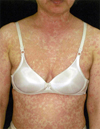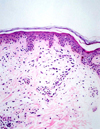Abstract
We describe a 59-year-old female with severe anticonvulsant hypersensitivity syndrome (AHS) associated with Epstein-Barr virus (EBV) infection. The causative drug was speculated to be carbamazepine. Recurrent EBV infection was demonstrated by the presence of anti-EBV early antigen IgM antibodies and anti-EBV nuclear antigen IgG antibodies. To our knowledge, only one case of drug hypersensitivity syndrome (DHS) associated with EBV has been reported in the English-language literature. Our case is the second report of EBV-associated DHS, which suggests that EBV infection may contribute to the pathogenesis of AHS in a few patients.
Anticonvulsant hypersensitivity syndrome (AHS) is a rare life-threatening drug-induced reaction most commonly associated with phenytoin, carbamazepine, and phenobarbital. In a broader sense, this syndrome is also called drug hypersensitivity syndrome (DHS), involving other drugs as well, such as sulfones, sulfonamide antibiotics, trimethoprim, minocycline, metronidazole, captopril, calcium channel blockers, mexiletine, fluoxetine, dapsone, terbinafine, allopurinol, azathioprine, and antiretrovirals.1,2 Clinical features include rash, fever, lymphadenopathy, internal organ involvement such as hepatitis, carditis, internal nephritis, or interstitial pneumonitis, and hematologic abnormalities such as leukocytosis with eosinophilia or atypical lymphocytosis.1-3 Unlike other drug reactions, this syndrome is caused by a limited number of drugs.1 It is also distinguished by its occurrence after prolonged exposure to the offending drugs, typically four weeks or more.1
The pathogenesis of anticonvulsant hypersensitivity syndrome is not clear even though genetic deficiency of detoxifying enzymes, epoxide hydrolase, resulting in accumulation of toxic metabolites, or virus-drug interactions, as seen in cases of human immunodeficiency virus and human herpes virus, are proposed as possible candidates.1,4 The reported viral infections associated with AHS have been human herpes virus-6 (HHV-6) infections in most cases, although one case of AHS was associated with cytomegalovirus (CMV) infection.5 More recently, allopurinol-induced drug hypersensitivity syndrome associated with Epstein-Barr virus (EBV) infection and DHS due to carbamazepine associated with reactivation of human herpesvirus 7 were also reported.6,7
Herein, we describe a AHS patient with EBV reactivation which developed four weeks after the initiation of carbamazepine therapy.
A 59-year-old female was admitted to our department with a 5-day history of generalized pruritic skin eruptions over her entire body, and a 3-day history of facial edema and fever (Fig. 1). Four weeks prior to admission, she was treated with carbamazepine, gabapentin, meloxicam, and cimetidine for 2 weeks in order to control intractable chronic neck pain. Examination revealed erythematous maculopapular eruptions over her entire body, icteric sclera, and cervical lymphadenopathy. Complete blood count showed leukocytosis (18 × 109/L, normal 1-10 × 109) with an increased lymphocyte proportion (neutrophils 39%, lymphocytes 41%). Peripheral blood smear showed five atypical lymphocytes. Liver function tests were abnormal with increased levels of AST (304IU/L, normal 13-37), ALT (636IU/L, normal 7-43), total bilirubin (3.6 mg/L, normal 0.2-1.3), direct bilirubin (2.1 mg/dL, normal 0.2-0.4), alkaline phosphatase (399IU/L, normal 42-117), and γGTP (762IU/L, normal 8-46). Urinalysis showed proteinuria (2+) and bilirubinuria (2+). Abdominal ultrasonography and computed tomography revealed marked gall bladder wall thickening and multiple lymphadenopathy at the portocaval, paraaortic, and retropancreatic areas, highly suggestive of drug induced hepatitis with reactive lymph nodes on the porta hepatis. A skin biopsy taken from the back showed basal cell vacuolization and superficial perivascular lymphocytic infiltration with some atypical lymphocytes in the dermis (Fig. 2).
Serologic tests to confirm viral origin were performed. Recurrent EBV infection was demonstrated by the presence of anti-EBV early antigen (EA) IgM antibodies and anti-EBV nuclear antigen IgG antibodies in the serum taken 5 days after onset of skin eruptions. Anti-HHV-6 IgG titer was measured at the same time with 1:40 positivity.
Other serologic tests were carried out to rule out viral hepatitis and autoimmune hepatitis. Absence of HBsAg and presence of Anti-HBs and Anti-HBc showed previous HBV infection with strong protective antibody titer (Anti-HBs Ab > 1000mIU/mL). A search for the hepatitis A and C viruses was negative. Tests for autoimmune markers such as antinuclear antibody and antismooth muscle antibody were also negative.
Corticosteroid treatment with dexamethasone 5 mg IM and concurrent oral methylprednisolone 24 mg was initiated on the fifth day of onset. Eight days after onset, the skin lesions and fever began to subside with the disappearance of proteinuria. Facial edema and lymphadenopathy also subsided on the ninth day of onset. Liver enzyme and total bilirubin levels gradually decreased as well. She was discharged from our hospital on the tenth day of onset. Corticosteroid was gradually tapered to a daily dosage of 6 mg methylprednisolone. However, on the 20th day of onset, the patient developed a recurrence of erythematous papules and plaques over her entire body accompanied by fever. The oral methylprednisolone dosage was increased to 16 mg/day. The patient responded well to this systemic corticosteroid treatment and the case was completely resolved within 2 weeks.
Hematological abnormalities in this patient consisted of a few atypical lymphocytes on the peripheral blood smear without eosinophilia. Hepatic involvement is also very common in EBV infection and varies in severity.8 Infectious mononucleosis can be ruled out in this patient by the clinical features, absence of atypical lymphocytosis in the complete blood count, and the history of carbamazepine intake. An excellent response to steroid treatment and recurrence after its tapering are also common features of AHS.9 The most likely causative drug in our case is considered to be carbamazepine since DHS is associated with only a limited number of the drugs mentioned above.1 To the best of our knowledge, AHS has not been described for gabapentin.
Interaction between drugs and viral infection has been proposed as one of the factors in the pathogenesis of AHS.10 There have been many reports of AHS associated with HHV-6 infection in cases and case series.10 Recently, viruses other than HHV-6 have been reported to be associated with drug-induced hypersensitivity syndrome. Aihara et al.5 reported AHS associated with CMV infection. DHS due to carbamazepine associated with reactivation of human herpesvirus 7 were also reported.7 Drug-induced hypersensitivity syndrome associated with Epstein-Barr virus infection was also reported with allopurinol as the causative drug.6 However, in that case the association with HHV-6 was not clear by the presence of anti-HHV-6 IgM antibodies and the failure to detect HHV-6 DNA by polymerase chain reaction (PCR) in the serum.6 Even though the relationship between viral infection and AHS is still complex and vague, Kano et al.11 suggested that continuous anticonvulsant therapy might cause decreased B-cell counts and immunoglobulin production in susceptible individuals, resulting in reactivation of HHV-6 and development of AHS.
We were able to demonstrate active EBV infection by the presence of anti-EBV early antigen (EA) IgM antibodies in our patient. We could also prove past EBV infection by the presence of anti-EBV nuclear antigen IgG antibodies. Thus, recurrent EBV reactivation was definitely associated with our case. Past infection of HHV was shown with the presence of anti-HHV-6 IgG. Even though HHV-6 reactivation could not be definitely determined in our patient, HHV-6 reactivation was not likely since the anti-HHV-6 IgG titer level was relatively low (1:40).
The role of EBV in the pathogenesis of DHS is still unknown. Viral infections may change drug metabolism or act as danger signals leading to an immune response.10 Recent studies demonstrated that EBV infection to B-cells induced the expression of host-encoded superantigens, which elicit potent antigen-independent T-cell responses.12 Descamps et al.6 proposed that EBV amplifies the T-cell activation induced by drugs and also participates in the development of visceral manifestations. To the best of our knowledge, this is the second report of DHS associated with EBV infection. The previous report was associated with allopurinol and EBV infection. Since carbamazepine is frequently used to control chronic pain in various clinical settings, including herpes zoster, dermatologists should be aware of this syndrome to prevent mortality by early diagnosis and intervention.
Figures and Tables
References
1. Sullivan JR, Shear NH. The drug hypersensitivity syndrome: what is the pathogenesis? Arch Dermatol. 2001. 137:357–364.
2. Tas S, Simonart T. Management of drug rash with eosinophilia and systemic symptoms (DRESS syndrome): an update. Dermatology. 2003. 206:353–356.
3. Turner RB, Kim CC, Streams BN, Culpepper K, Haynes HA. Anticonvulsant hypersensitivity syndrome associated with Bellamine S, a therapy for menopausal symptoms. J Am Acad Dermatol. 2004. 50:5 Suppl. S86–S89.
4. Yoo JH, Kang DS, Chun WH, Lee WJ, Lee AK. Anticonvulsant hypersensitivity syndrome with an epoxide hydrolase defect. Br J Dermatol. 1999. 140:181–183.
5. Aihara M, Sugita Y, Takahashi S, Nagatani T, Arata S, Takeuchi K, et al. Anticonvulsant hypersensitivity syndrome associated with reactivation of cytomegalovirus. Br J Dermatol. 2001. 144:1231–1234.
6. Descamps V, Mahe E, Houhou N, Abramowitz L, Rozenberg F, Ranger-Rogez S, et al. Drug-induced hypersensitivity syndrome associated with Epstein-Barr virus infection. Br J Dermatol. 2003. 148:1032–1034.
7. Hara H, Kobayashi M, Yokoyama A, Tochigi M, Matsunaga A, Shimizu H, et al. Drug-induced hypersensitivity syndrome due to carbamazepine associated with reactivation of human herpesvirus 7. Dermatology. 2005. 211:159–161.
8. Hinedi TB, Koff RS. Cholestatic hepatitis induced by Epstein-Barr virus infection in an adult. Dig Dis Sci. 2003. 48:539–541.
9. Valencak J, Ortiz-Urda S, Heere-Ress E, Kunstfeld R, Base W. Carbamazepine-induced DRESS syndrome with recurrent fever and exanthema. Int J Dermatol. 2004. 43:51–54.
10. Wong GA, Shear NH. Is a drug alone sufficient to cause the drug hypersensitivity syndrome? Arch Dermatol. 2004. 140:226–230.
11. Kano Y, Inaoka M, Shiohara T. Association between anticonvulsant hypersensitivity syndrome and human herpesvirus 6 reactivation and hypogammaglobulinemia. Arch Dermatol. 2004. 140:183–188.
12. Asada H, Miyagawa S, Sumikawa Y, Yamaguchi Y, Itami S, Suguri S, et al. CD4+ T-lymphocyte-induced Epstein-Barr virus reactivation in a patient with severe hypersensitivity to mosquito bites and Epstein-Barr virus-infected NK cell lymphocytosis. Arch Dermatol. 2003. 139:1601–1607.




 PDF
PDF ePub
ePub Citation
Citation Print
Print




 XML Download
XML Download